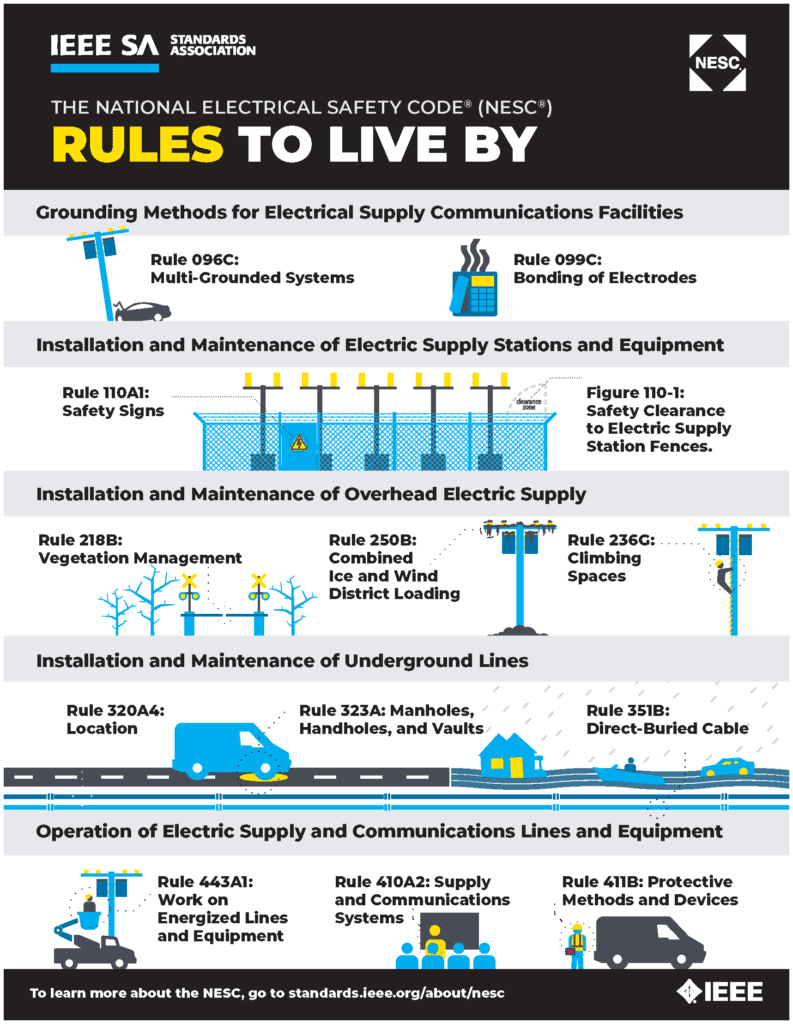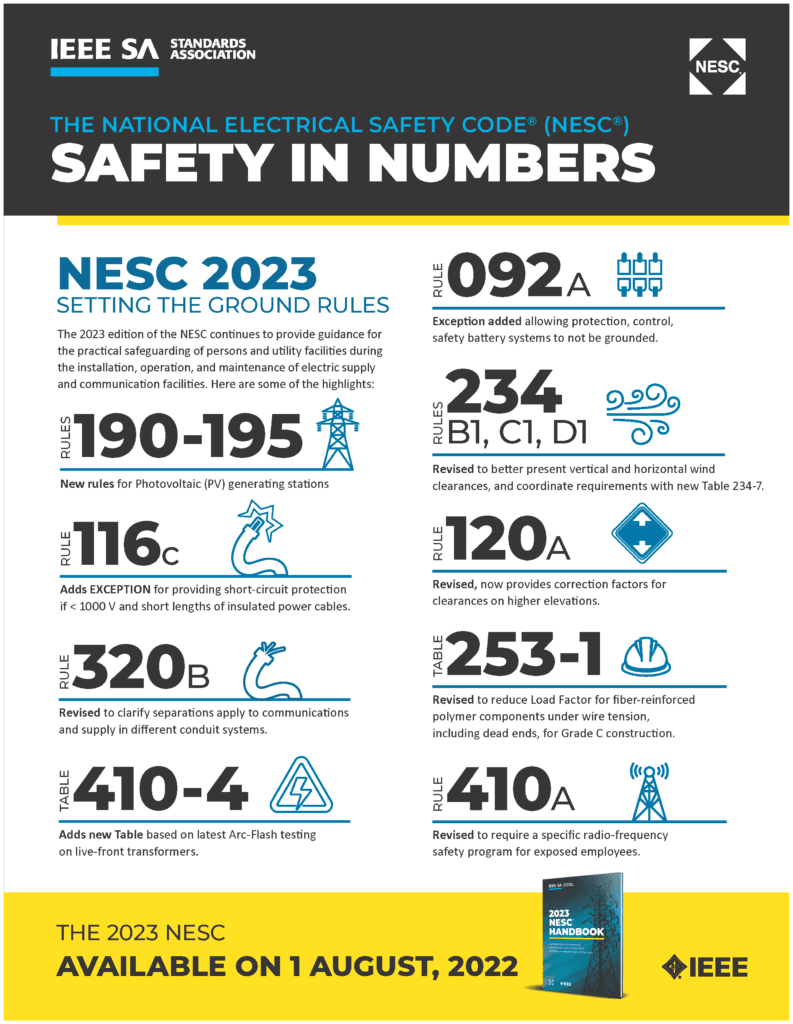Since 1914, the National Electrical Safety Code® (NESC®) has been the go-to safety standard for electric and telecom utility companies of all sizes and ownership of structures.
Updated every 5 years, the 2023 edition of the NESC was released 1 August 2022 and will become effective 1 February 2023.
What is the National Electrical Safety Code (NESC)?
Edited and published by the IEEE Standards Association (IEEE SA) and approved by the American National Standards Institute (ANSI), the NESC has contributed to major electrical safety codes in most states in the United States, Caribbean, US Territories, US military bases as well as other entities and countries throughout the world.
Not to be confused with the National Electrical Code® (NEC®), which primarily addresses indoor wiring of homes and businesses, the NESC focuses on the outdoor lines that connect to homes and businesses to deliver power and communications, the electric supply stations and telecommunications plants, and their overhead and below ground structures.
Sections of the Code cover electrical grounding, electrical substation safety, overhead power line safety, underground power line safety, and safety-related work practices.
For more than 100 years, power and energy engineers, public, private, and cooperative utilities, U.S. state and local-level regulatory and policy authorities, academia research professors and students, telecom industry experts, and renewables industry stakeholders have been volunteering their time to review and suggest updates to the National Electric Safety Code.
What Are the 2023 NESC Updates?
- New rules 190-195 for photovoltaic (PV) generating stations.
- Rule 116c adds an exception for providing short-circuit protection if less than 1000V and short lengths of insulated power cables.
- Rule 320B is revised to clarify separations apply to communications and supply in different conduit systems.
- Table 410-4 adds a new table based on the latest Arc-Flash testing on live-front transformers.
- Rule 092A added an exception allowing protection, control, safety battery systems to not be grounded.
- Rules 234 B1, C1, D1 are revised to better present vertical and horizontal wind clearances, and coordinate requirements with new Table 234-7.
- Rule 120A is revised and now provides correction factors for clearances on higher elevations.
- Table 253-1 is revised to reduce load factor for fiber-reinforced polymer components under wire tension, including dead ends, for Grade C construction.
- Rule 410A is revised to require a specific radio-frequency safety program for exposed employees.
What Are Other Notable 2023 NESC Revisions and Forecasts?
In addition to updating the Code to reflect burgeoning technology, other goals during the NESC revision period were to make long standing sections clearer and begin research on foreseeable changes between publications.
For example, tables that include both English and metric values, the inch-foot-pound system will be followed by the corresponding metric values in parentheses to showcase both measures and help prevent user error.
In addition, new working groups of the NESC Subcommittees were formed to investigate up and coming topics including generating stations and Fault Managed Power Systems (FMPS) cables as the technology may be used for 5G networks.
How Do the NESC Updates Impact Stakeholders?
Updating the NESC is necessary to better protect workers, the public, and facilities during the installation, operation, and maintenance of power and communications supplies.
The updates ensure the Code remains relevant, as new technologies come into use, as well as trustworthy, as safer ways of working are realized. For these important reasons, the NESC enters a stringent review and proposal process resulting in a new edition being released every five years.
Job roles dependent upon the NESC include:
- Utility company business leadership, operations management, engineering and line design, crew supervisors, and safety trainers
- Providers of power, telecommunications, cable TV, wireless, and Internet
- Railroads for their power and signaling system
- Manufacturers of electrical equipment and associated product testing agencies
- Consultants and contractors that assist in the design and construction of utility lines and infrastructure
- State and federal regulatory agencies that provide industry oversight
Order the 2023 NESC
Supplementary to the Code is the NESC Handbook which presents commentary by contributors to help professionals improve their understanding of the NESC and how it might be applied. Topics include introduction and changes to the NESC, electrical grounding, rules for installation and maintenance of electric supply stations, overhead, and underground electric supply, and rules for operation of electric supply and communications lines and equipment.
Get Involved in Future Editions
The 2023 NESC editorial process is coming to an end with the publishing of the Code on 1 August 2022. However, this is the perfect time to join this motivated team and apply your knowledge to future editions to help protect yourself, co-workers, and power and communications users. Become an NESC member; there are new and important working groups and tasks at hand that would need your expertise. We welcome you to help us evolve the Code as technology and needs change.










